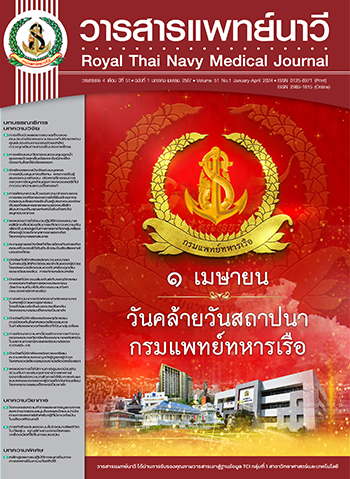Prevalence and Associated Factors of Computer Vision Syndrome among Radiologists, Thailand
Main Article Content
Abstract
A cross-sectional study conducted among Thai radiologists aimed to investigate the prevalence and factors associated with Computer Vision Syndrome (CVS). The prevalence of CVS was assessed using an online CVS-Questionnaire in Thai version, showing an Index of Item Objective Congruence (IOC) ranging from 0.67 to 1. The Chronbach's alpha coefficient was 0.88. A total of 285 individuals, including radiologists and radiology residents, actively participated in the study. The collected data were analyzed using descriptive statistics, bivariate analysis, and logistic regression analysis. The results showed a high prevalence of CVS at 82.81%. Factors associated with CVS included subspecialties (aOR = 0.19, 95% Cl: 0.06 - 0.60) pre-existing eyeconditions (aOR = 4.97, 95% Cl: 1.74 - 14.14), taking eye breaks while working (aOR = 0.20, 95% Cl: 0.08 - 0.49). In conclusion, Thai radiologists showed a high CVS prevalence. Taking regular breaks at work may help to prevent and reduce this syndrome.
Article Details

This work is licensed under a Creative Commons Attribution-NonCommercial-NoDerivatives 4.0 International License.
References
American Optometric Association. Computer vision syndrome. [Internet]. [cited 2022 October 20]. Available from: https://www.aoa.org/healthy-eyes/eye-and-vision-conditions/computer-vision-syndrome?sso=y.
Blehm C, Vishnu S, Khattak A, Mitra S, Yee RW. Computer vision syndrome: a review. Surv Ophthalmol 2005;50(3):253-62
Swartz NG. Cohen MS. Tearing and the lacrimal system. In: Gault JA., editor. Ophthalmology secrets. 5th ed. Philadelphia: Elsevier; 2022. p. 265-9.
Alhasan AS, Aalam WA. Magnitude and determinants of computer vision syndrome among radiologists in Saudi Arabia: a national survey. Acad Radiol 2022;29(9):e197-e204.
Taylor-Phillips S, Stinton C. Fatigue in radiology: a fertile area for future research. Br J Radiol 2019;92(1099):20190043.
Del Mar Segui M, Cabrero-Garcia J, Crespo A, Verdú J, Ronda E. A reliable and valid questionnaire was developed to measure computer vision syndrome at the workplace. J Clin Epidemiol 2015;68(6):662-73.
Wangsan K, Upaphong P, Assavanopakun P, Sapbamrer R, Sirikul W, Kitro A, et al. Self-reported computer vision syndrome among Thai university students in virtual classrooms during the COVID-19 pandemic: prevalence and associated factors. Int J Environ Res Public Health 2022;19(7):3996.
Katz Mh. Multivariable analysis: a practical guide for clinicians and public health researchers. Cambridge: Cambridge University Press; 2011.
Anbesu EW, Lema AK. Prevalence of computer vision syndrome: a systematic review and meta-analysis. Sci Rep 2023;13:1801.
Al Dandan O, Hassan A, Al Shammari M, Al Jawad M, Alsaif HS, Alarfaj K. Digital eye strain among radiologists: a survey-based cross-sectional study. Acad Radiol 2021;28(8):1142-8.
Haerem T, Rau D. The influence of degree of expertise and objective task complexity on perceived task compleaxity and performance. J Appl Phychol 2007;92:1320.
Vertinsky T, Forster B. Prevalence of eye strain among radiologists: influence of viewing variables on symptoms. AJR AM J Roentgenol 2005;184(2):681-6.
Baccardo L. Seft-reported symptoms of mask-associated dry eye: a survey study of 3,605 people. Cont Lens Anterior Eye 2022;45(2):101408
Fan Q, Liang M, Kong W, Zhang W, Wang H, Chu J, et al. Wearing face mask and possibility for dry eye during the COVID-19 pandemic. Sci Rep 2022;12(1):6214.
Mohamed-Noriega K, Charles-Cantu DE, Mohamed-Noriega J, Velasco-Sepúlveda BH, Morales-Wong F, Villarreal-Méndez G, et al. Face mask and tear film stability: a pilot study of the objective measurement of tear break-up time. J Clin Med 2023;12(24):7727


